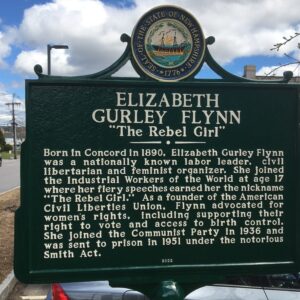Imagine there’s no marker.
The now-infamous historical highway marker honoring home-grown Communist Elizabeth Gurley Flynn keeps causing headaches for the state.
A month after Gov. Chris Sununu had the state marker removed from its street corner in Concord, supporters of a commemoration of “Rebel Girl” Flynn are considering a lawsuit to get it put back.
“We are looking into options,” activist Arnie Alpert told NHJournal.
Alpert and Mary Lee Sargent, both long-time leftist organizers, filed the original petition for the state to erect the marker for Flynn. They also organized its unveiling on May Day, “one of the most important holidays in communist countries such as China, Cuba, North Korea, and the former Soviet Union,” according to Wikipedia.
When Republican members of the state’s Executive Council discovered who the marker was honoring and her history as an unrepentant Stalinist who sided with Moscow during the Cold War, they were outraged. They demanded answers from the Sununu administration, particularly the New Hampshire Department of Natural and Cultural Resources, about how such an honor could be approved and paid for by the state.
Under pressure, Gov. Chris Sununu first blamed Concord city leaders for the commemoration before conceding it was entirely a state project and having the marker pulled down.
Now Alpert and Sargent have brought progressive lawyer Andru Volinsky to restore the sign. Volinksy told NHPR the state broke its own rules when it had Flynn’s maker removed. Volinsky said the matter could be pursued in court as a violation of New Hampshire’s Administrative Procedures Act.
“In this case, there were rules and policies for historical markers both erecting and removing them,” Volinsky said. “It seems as though the rules to erect the marker were followed. Then some people issued an edict, and it was removed without following the rules. So, there are ways to enforce those rules through the court system.”
Alpert and Sargent warned the state before the marker came down that state rules need to be followed. In a letter they sent to Natural and Cultural Resources Commissioner Sarah Stewart, Alpert and Sarget cited her department’s rules regarding the removal of markers.
“At this time, there are no grounds for the marker’s removal which are consistent with your department’s policies,” they wrote.
They noted that the rules for getting a marker “retired” are specifically tied to the marker’s condition and not any prevailing political sentiment.
“The policy for retirement deals with markers that contain errors, are in a state of disrepair, or require refurbishment. None of these criteria apply to the marker in questions that would in any way justify its retirement,” Alpert and Sargent wrote.
Stewart has not responded to Alpert and Sargent’s letter, according to Volinsky.
Flynn was born in 1890 in Concord. Her family moved to New York City when she was 10. She became a socialist activist in her teens, eventually helping to found the American Civil Liberties Union. In 1936 she joined the Communist Party USA (CPUSA), eventually rising to national chairwoman in 1961.
When Flynn joined the Communist Party in 1936, the Soviets had already murdered close to 9 million people in Ukraine and other territories in what is now known as the Holodomor. Another 1.2 million were about to be killed in Stalin’s great purge. When she became head of the American Communist Party, dissident writer Alexander Solzhenitsyn was just a few years removed from serving a decade in the Soviet gulags and internal exile.
Her decision to join the Communist Party during Stalin’s purges and high-profile show trials is particularly disturbing. In fact, Flynn was expelled from the ACLU over her membership in the CPUSA. A decade later, she was found guilty under the Smith Act for advocating the overthrow of the U.S. government by force and violence.
The Soviet government gave Flynn a state funeral in Red Square, with more than 25,000 people attending.
When Flynn joined the Communist Party in 1936, the Soviets had already murdered close to 9 million people in Ukraine and other territories in what is now known as the Holodomor. Another 1.2 million were about to be killed in Stalin’s great purge. When she became the head of the American Communist Party, dissident writer Alexander Solzhenitsyn was just a few years removed from serving a decade in the Soviet gulags and internal exile.
Volinsky told NHPR he hopes to be able to negotiate a resolution with the state.
It’s easy if you try.




